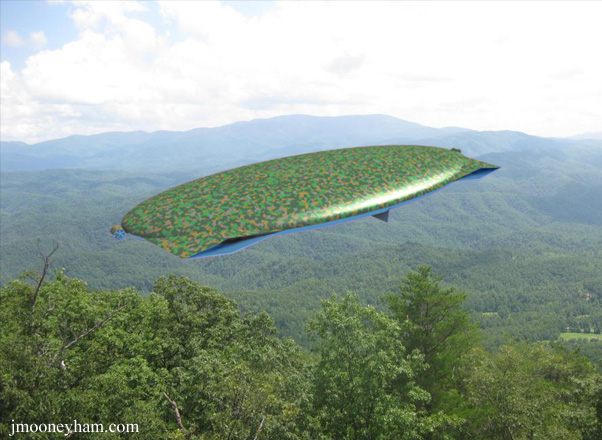The account below was inspired by actual events. Details like names, dates, and more have been changed for reasons of privacy and readability.
[Caution: This page is meant for entertainment and historical documentation purposes only.]
Building an airship is a formidable task. Especially on a shoe-string budget (and learning by trial and error). But it can be done.
Unfortunately, in many ways it was far tougher in the 1970s than today.
What I wanted most at the time was something like a flying car or Jetson-mobile. Basically a roughly car-sized VTOL (vertical-takeoff-or-landing craft) capable of parking in a driveway like an automobile and traveling at least 100 mph while cruising sky-wise. With a minimal range of several hundred miles on a tank of fuel too. I also wanted it to be super-safe in emergencies, and be able to tote at least one passenger plus a carload's worth of groceries or supplies at the same time as a pilot.
I wanted the flying power and functionality of a helicopter without the dangerous giant rotating knives, the complex piloting and maintenance requirements, and the near zero backup facilities in case something went wrong with the main drivetrain.
And a working model of all this had to built for not more than a few thousand dollars, and in just a few months. Preferably by me alone, in absolute secrecy.
But then reality intruded. When I began researching how I might build such a thing it turned out that it was impractical and too expensive even for the richest people and organizations in the world-- even for superpower militaries like America's own, and the richest men on Earth.
Doh! As Homer Simpson might say.
But I was determined. Having already built my own supercar and trained myself to drive it , plus proven (to myself at least) that I could accomplish some things others said were impossible, I figured this too had to be within my reach. Somehow.
After all, for most all past breakthroughs in history, there had to be a first time. And often before that first time everybody and their mother was saying it couldn't be done. Heck, the Wright brothers had to keep flying their plane in front of and above observers for years before everyone finally and reluctantly agreed they had actually invented a working airplane.
So I was undeterred. But as I learned more I gradually came around to realizing that if I was going to accomplish anything at all I'd have to drastically scale back my ambitions, and "go with the flow" of where the actual physics and economics involved took me.
Heck, I didn't have billions of dollars to throw at stuff like the US government. I'd be lucky to scrounge up enough to qualify as thousands for such a project (as in just barely plural).
And restricting the available manpower to just myself was awfully limiting too. I did eventually take on one partner. Though for both his protection and my own I kept him in the dark as to what the project really was all about. He knew everything about it was super lightweight, and the overall thing might eventually be humongous: but so far as I know he never realized it was going to go airborne. At least not during the initial buildup. It helped that he was mainly interested in other things at the time.
I managed to contract out some of the labor and footwork involved in other ways too. For instance, there was an awful, awful lot of meticulous sewing involved. Luckily there was a pool of experienced sewers just over the state line already doing piece-work for a certain apparel company for near slave-wages. And a great many of them had machines at home too. So I determined who the best skilled among them were, and then who among those wanted to make a little extra on the side. It also helped that I didn't always have to pay cash for these services, but sometimes was able to barter for them. Many of the sewers were middle-aged or older women, with various things like house and auto repairs they could really use a handy-man for. As I'd worked along-side some of these women in the same factory for a while, I had a headstart on the trust side too.
Never underestimate the power of little old ladies:
"The inner bladder of the space suits—the airtight liner that keeps the astronaut’s body under Earth-like pressure—and the ship’s computer’s ROM chips were handmade by teams of "little old ladies."
-- Ten Things You Didn't Know About the Apollo 11 Moon Landing By Craig Nelson Posted 07.13.2009
In those days I was fairly savvy at buying big lots of stuff on the cheap for cash and then making money or other profit by divvying it up and selling (or trading) it in far smaller quantities at significant markups over cost. This also often left me with a fairly good-sized stock of certain commodities for bartering purposes, over and beyond the original deals made. Some of this went into my private bartering stock for use after nuclear war, and part to lubricate other ongoing deals of the time. It gave me extra negotiation capital-- at least in some cases.
Actually obtaining the copious amounts of synthetic fabric involved was harder. Luckily there were some cheap industry source connections to be found among the sewers themselves. And I put the word out to some fellow wheeler-dealers about certain items to keep watch for in their travels as well. Eventually I had quite a pile of discarded nylon camping tents and hammocks, among other things.
Only some small number of years before, a synthetic fiber production plant had opened up just some 30 miles or so from my home town. My mom as well as some uncles and other relatives ended up working there over time. For some unfathomable reason this potential source of fabric eluded my personal roster of possibilities for some months, before I realized what was under my nose.
But of course, before any of the actual construction could take place I had to determine my design. This turned out to be incredibly difficult, because almost everywhere I turned the books kept telling me mostly what I could NOT do, rather than what I COULD do.
The true source of this page is 
It was exasperating.
After much toil and trouble though I finally nailed down a preliminary design. A sem-rigid airship that would basically be a huge hot air balloon with a collapsible and shape-changing horizontal frame running through its middle.
I thought I'd learned a lot about working with weight restrictions on Shadowfast, and I had. But the weight constraints on Moonshadow were in a whole other league.
Basically I had to try to become a one-man NASA with a mouse-squeak budget, and working with materials which might frequently be found at the city dump.
My indoctrination into lighter-than-air and ultra-lights technology was much tougher and lonelier than the trek I'd pursued to design, build, and drive my supercar. For virtually nobody in my parts built and flew aircraft. And I couldn't get my family or friends involved due to both the physical and legal risks accompanying my project. The local libraries barely covered WWII legacy aircraft design: no way I could find anything there on more cutting edge stuff. Oh sure, on rare occasion I ran across a standard hot air balloon flyer, or witnessed a gyrocopter pilot run himself through a barbed wire fence (ow!). And rode in a helicopter. But none of those things really helped much towards my own project.
Sure, I checked out the gyrocopter plans and kits available at the time. But wasn't satisfied with them. By a long shot. They were horrendously expensive, and the end result didn't offer the minimal things I wanted in an aircraft. Do-it-yourself helicopter kits were even worse in all those respects.
|
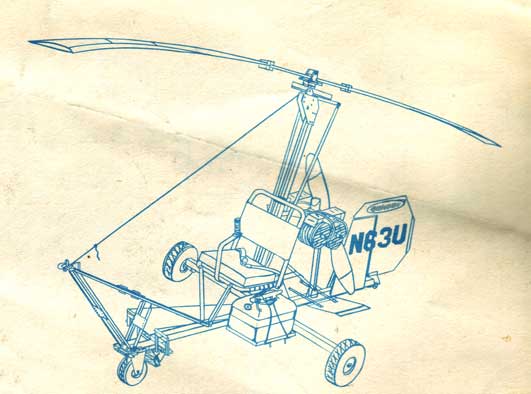
Above is a snapshot of a piece of gyrocopter blueprints I bought to examine during my research.
|
|
One major breakthrough in the project happened when I came across a near complete back issue archive of Popular Science and Popular Mechanics magazines ranging from near modern day to almost WWII(!)
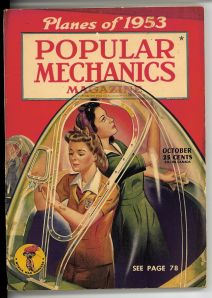
Above can be seen the only magazine left of my original hoard. Somehow it got left behind when I gave the stacks to my friend.
|
That archive was a goldmine of all sorts of info, on many subjects. Of which lighter-than-air and ultra-light aircraft construction were merely two.
I found the archive deep in the North Carolina mountains, in the second story of this little used bookstore, sitting in lots of old plastic milk crates and ready to be carried out. I immediately bought the entire lot after browsing through a few issues. Fortunately I was driving a pickup truck that day.
I would end up data mining that archive for years to come.
I literally went through hundreds of different designs before settling on one which seemed to offer the best fit between my resources and goals of the time. Plus whose numbers crunched out to practical functionality.
|
|
But gosh the thing was big. Much bigger than the unschooled in this sort of thing might expect. It takes an awful lot of hot air to lift even two or three people's worth of weight. But by modifying my plans and parameters I adapted to the great size.
Moonshadow ended up being basically an enormous balloon which could shape-change from a blimp-like configuration to something more like a plump flying wing in mid-flight.
I accomplished this by basically having a lightweight frame running horizontally through its middle, that I could extend or shorten somewhat the same way as the sails on sail boats are modified by hand-winches. And the envelope, attached to the framework, would follow. Of course I had to make sure I didn't cause the fabric to bunch up or stretch too much in either mode or in-between. And I couldn't afford to simply add much fabric for additional slack due to the ever-present weight problem either.
My on-going engineering education helped tremendously with such details. For example, there's relatively straightforward ways to mathematically determine the total area of envelope fabric required to meet several converging goals at once in such a design. One reference which I used for this and many other projects since is an old Schaum's Outline series book by M.R. Spiegel I believe, published by McGraw-Hill. Its title was MATHEMATICAL HANDBOOK. Today my copy is missing its cover and first couple pages or so, leaving me with no copyright date to give you. This book and my Pop Sci/Pop Mech archives may be the only documents relating to Moonshadow to escape the ultimate materials confiscation which eventually ended the project. A college friend had borrowed my Mathematical Handbook for the summer, and the archives weren't being stored at my current address of the time. Sometime after that I gave the magazine archives away to another friend I thought might find them useful, who may still own them to this day.
Basically the feds didn't know about my main war bunker and its reference library, which were wholly separate from my various living locations of the time. Unfortunately all my Moonshadow materials but for the magazine archives and handbook were in the wrong place at the wrong time, leaving me today bereft of practically all evidence I ever built Moonshadow at all. Except for what's in my head. But even that I was forbidden to discuss for some indefinite period (they wouldn't even give me a copy of what they made me sign, so I can't reference it now for the period originally specified). But now decades later the point seems moot.
For the very hardest calculations involved in Moonshadow's design you'd also include the use of very basic calculus. So a decent high school student circa 2005 should be able to do all the math I used for Moonshadow.
One design headache involved switching over the control surfaces to accommodate the shape-change. Because the front of the blimp-shape would end up as the right wing tip of the newly formed wing-shape. Etc.
Plus, the frame supported a third mode of operation. That is-- when nesting-- I could fold the whole frame in half with main pivot points located at the front-most and rear-most ends of the blimp-configuration.
This folding would make it easier for me to get the whole shebang quickly deflated and down through the tree tops and to the ground, if necessary.
The control surfaces were rigged so I could run them up and around the sides of the blimp or wing like flags up and down a flag-pole.
Long fiberglass rods situated at the control surface home positions gave them the backbone required, while high-strength fishing line acted to move them from their default positions for maneuvering the craft.
For redundancy reasons I used at least two separate strands of high strength fishing line for every control run on the craft-- and three for a few critical items. Most of these duties wouldn't have taxed even a single strand of the material, but I was paranoid about losing control in a critical moment. I also inspected all the lines as frequently as I could. Keep in mind that when inflated and airborne Moonshadow was enormous, and the fishing lines were absolutely the only means I had to affect certain remote operations on the craft.
The horizontal control surfaces themselves were unfurled slices of nylon (much like tent material) cut and sewn to fit. The vertical rudder was a similar work.
The speeds available? Well, using no propulsion at all and merely acting as a balloon in blimp configuration, Moonshadow could attain something equivalent to the prevailing wind speeds at the time-- and in the same direction. Which was almost never the way I wanted to go. Plain hot air balloons can't be used for much serious purpose but plain vertical height gain for observation purposes while tethered to the ground, or for possible escape from a hairy ground situation. Of course if there's no wind you'd eventually simply descend again into the waiting hands of your enemies. So a standard hot air balloon won't do much for you.
(Yes, it is often possible to change your altitude to find a wind-- and maybe even keep changing until you find the wind blowing in your preferred direction-- but I was unwilling to go very high in Moonshadow unless forced into it)
But in Moonshadow's fat wing configuration I could get much more directional influence and a top speed of around maybe 40-50 mph! (using my windmill thrusters)
Of course it could take me a little while to reach top speed. And having a tail wind helped a lot, while a head wind hurt the same amount.
I'd take off and land in blimp mode, which helped reduce the belly exposure to raking tree branches during nesting. I needed to already be in the air to transform to wing mode, especially with a heavy load, for Moonshadow could lose some altitude during the transition. If I was very lightly loaded I could transform at lower altitudes.
Yeah, it took me a while to get the hang of it. But it helped that I'd previously studied every airship and ultra light aircraft account I could find, plus tried to consider every contingency in my design.
In hindsight though, I would probably have benefited a lot from some sailboat piloting as well.
My windmill thrusters
The left and right tips of the wing configuration (or the tail and nose of the blimp mode) also sported thrusters. Windmill type arrangements of fiberglass rods and fabric encircled by mostly fabric nacelles, and powered by compressed air. Each thruster in full deployment was a little bigger than a Volkswagon Beetle of the era.
These helped with the steering in both blimp and wing-mode, but as I could change their orientation as well, I often pointed their thrust down while switching to wing-mode in order to compensate for the small loss in buoyancy.
They were also useful for low end forward acceleration (or braking) in wing mode. But for mid-range to top end speeds I needed to minimize their front surface area and basically turn them off, depending instead on the main propulsion system and control surfaces.
Being basically constructed much like collapsible camping tents, I could actually cause them to flatten in profile down to under a foot in thickness remotely in flight, and still further by hand for storage purposes.
Burper propulsion
So what was my primary propulsion system? Well, I used my own crude variation of the sophistocated fuel-air explosion system on that military prototype I witnessed as a college intern. Moonshadow's maneuvering flaps at either end of the flying wing mode were double layered to form a flat pocket in normal flight, and protected by a flame resistant coating, inside and out. They didn't have to withstand any appreciable time spans of high temperatures, as the fireballs produced were more like very brief flashes, rather than sustained flame. Events lasting maybe half a second. And almost always separated by several whole seconds, or even minutes, in practice. So there was usually plenty of time for the hardware to cool down. The forward edge was closed, and basically attached directly to the airship's frame. The rear facing edge was normally closed, but possessed flexible fiberglass poles sewn into the fabric there so the whole envelope could open like a mouth to expel hot gas.
I could pull certain control lines and the maneuvering flaps (or just one of them) would expand from their normal flat condition to something more like a bulbous bag-- due to the flexible rods in the rear becoming curved, and shaping the fabric attached to them.
Fuel would then be precisely sprayed into the volume (this part was tricky, as excessive 'spotting' of fuel inside the pocket could be disasterous) and ignited.
The force had nowhere to go but backwards.
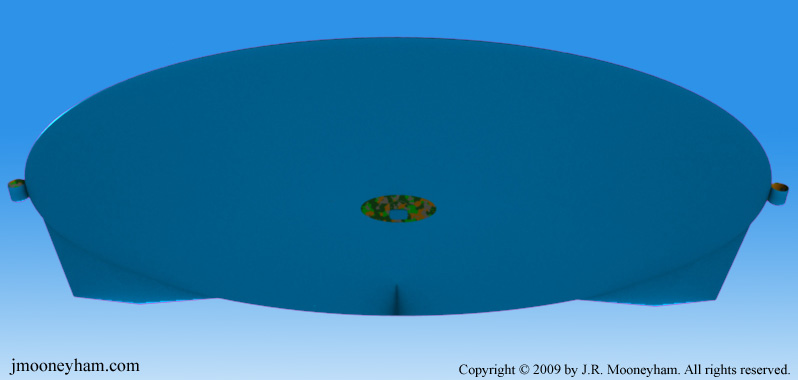
Above, an artistic rendition of Moonshadow's bottom half in daylight, with burpers opened by J.H. Mooneyham.

Above, an artistic rendition of Moonshadow's bottom half in daylight, with burpers opened; side view by J.H. Mooneyham (various control lines and mechanisms not shown).
Sort of by accident these flexible nozzles didn't provide direct thrust ahead, but angled it more towards a line bisecting the central axis of the airship in wing-mode, behind. Yeah, I sort of screwed up in the design there. So it turned out not being nearly as efficient or fast as it could have been. And exerted more and different stresses on the airframe than I'd intended. But I found ways to adapt to my mistake.
By properly managing my 'burp' propulsion (as I liked to think of it), I could achieve brief spurts of considerably higher speeds with Moonshadow than were otherwise available. But due to my original design mistakes, using the burpers for more than a few pulses at a time was awfully scary, and could easily lead to a loss of control of the ship. Certain aspects of the material used for the flaps also caused the effective burper thrust vectors to tighten up still further in extended use, weakening their desirable propulsive potential while at the same time exerting ever worse stresses on the airframe. Yikes! Ergo, I usually held them in contingency reserve after tests showed me the particulars of all this. And by that point I was simply too tired of the whole design and assembly process to take on a complete redoing of the flap burp system. I figured I'd make do with it as it was. And truth be told, after I fully understood the limitations and dangers in my flawed design, I was able to get along with it fine. In most cases.
There was also another good reason not to use the burpers very often. Namely, stealth. Moonshadow flew almost exclusively at night. But the burpers emitted huge (if very temporary) plumes of flame when they operated. So I lost my invisibility when I used the burpers at night.
Of course, the main burner used to heat up the air in the envelope wasn't stealthy either at night. In fact, Moonshadow's vast volume, enclosed by such a thin sheet of material-- with the burner flame shining not far below the center of the space-- would light up like a giant Christmas tree ornament at night, glowing all over.
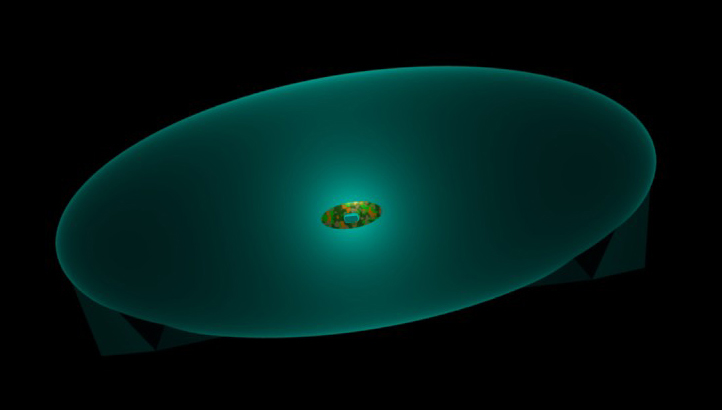
Artistic rendition of Moonshadow's bottom half, lit up by the burner flame inside at night, by J.H. Mooneyham (rudder and thrusters not shown).
The manuevering flaps didn't glow or emit flame except when burper propulsion was being used. So the result of using just the balloon burner after dark could make Moonshadow resemble a somewhat distorted flying saucer.
In practice I'd mainly use the main burner around sunset to inflate the envelope, when its glow would easily be lost against the ambient light of the retreating sun, as well as cloaked by Moonshadow's darker colored top half, as the craft gradually arose from its moored nesting position among the tree tops. In that situation most anyone who might detect the burner glow would have to be located on another hill top in direct line of sight of mine-- and so pose no immediate danger to my operation. And as I didn't (usually) actually launch until after full darkness had descended, even someone who saw the flame and the airship hovering among the tree tops during twilight usually wouldn't be able to decipher what it was they were witnessing.
And I could usually turn off the burner completely before taking off. So if someone watched my whole launch sequence at sunset and after, they'd see something awfully strange on that hilltop until night fell, then all the lights would go out, and they'd see nothing else.
Or very little indication that whatever-it-was ended up flying up into the sky.
Night vision goggles were practically non-existent back then.
I could spin Moonshadow around on a dime with the burners. Or scoot across the sky considerably faster than most people would expect a balloon to be capable of. But sustained use of the burpers on Moonshadow was like pushing the USS Enterprise starship's warp engines far beyond their design limits. Sure, maybe I could hit up to 90 mph with them for a few seconds. But the experience was way too terrifying to do except in a true emergency. And there was always the chance I might set my burper flaps on fire (or tear Moonshadow apart) if I used them too long.
Yes, you might have noticed when I used burper propulsion that basically took my flaps out of action, in terms of their normal maneuvering functions. But keep in mind Moonshadow had both aerostatic (balloon) and aerodynamic (wing, wind mill thrusters, and rudder) methods for maneuver-- even without the flaps.
But all other things being equal, the burpers tended to make Moonshadow gain altitude when used. I guess because of the crude flying wing shape. This was yet another reason I didn't like to use them: because I hated getting too high.
If I'd put Moonshadow into the steepest downward dive I could just prior to lighting the burpers, he might continue down a little ways before turning up again. But that was about the only way to head down even temporarily with the burpers (without also taking different actions with other components). But pointing us down like that prior to burping wasn't practical for most circumstances, as we weren't usually very high up to start with, and doing so could wreck us in tree tops or onto a jagged rock cliff. In the dark(!)
Airship frame/envelope
Naked-- and in blimp-shape-- my collapsible, shape-changing frame looked like a great ellipse from a top perspective.
The guts of the elliptical bisected frame consisted mostly of hollow central telescoping compressive member tubing with tensile members (ropes) running inside them.
The central bisectors (both long-ways and other) of the elliptical frame could be telescoped larger or smaller according to a hand crank mechanism in the belly of the balloon.
When they were cranked longer, the ropes inside would force shorter tubes pivoting on either end of the main bi-sector to rotate from an inwards facing direction to an outwards one. This motion helped create the proper wing shape. Or when reversed, return to the blimp configuration.
Everything was dimensioned so that the surface area of the wing shape was very near the same as that of the blimp shape: ergo, no appreciable stretching or bunching of the fabric skin was necessary along the way. It was by no means perfect, but a few wrinkles or soft spots here and there didn't matter all that much at the typical speeds we traveled.
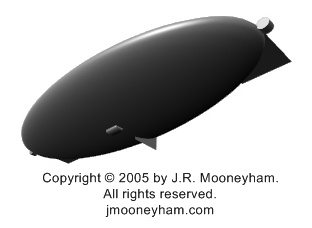
Above is the view a ground observer might have had of the Moonshadow flying wing-- at least with nightvision googles or the like-- since it flew almost exclusively in the dark of night.
|
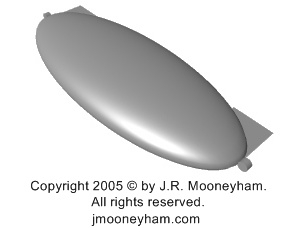
Above is a top view of Moonshadow in flying wing mode.
|
|
Open air bridge/cockpit
Although I had small mechanisms and nets dotting the exterior for various purposes, such as rigging the exterior control surfaces, my main cabin and payload area dangled below the airship, centered underneath the frame.
This cabin of sorts was open air. But it wasn't necessarily uncomfortable. Recall we primarily flew on peaceful summer nights. And the hot air in the balloon tended to keep me warm regardless of a cool night. Especially in wing mode, when the cabin would tend to be drawn closer to the main body of the balloon due to the design.

OK, though it may disappoint many out there, my cabin was basically a large inflatable rubber raft slung beneath the balloon, with a thin but rigid floor installed. Plenty of tie downs and webbing all around kept me and my ship's "hard core" safe from falling out while maintaining good visibility.
Moonshadow nesting
When nesting I could use some lines and small pulleys to lower the raft a certain distance from the balloon-- but not usually all the way to the ground. Lowering the raft to ground or water was not a regular thing. Rather, I typically raised and lowered supplies like propane tanks, etc. But lowering the raft would lower the airship's center of gravity and help anchor it somewhat, plus gave me some flexibility in other matters.
I guess I should explain nesting. Basically I scoped out some good nesting spots beforehand and tried always to use those rather than some randomly picked one. Moonshadow in blimp mode could extend outriggers to catch in the tops of trees surrounding a nesting spot. These outriggers were strong but flexible bowed members, hinged at one end to the airship frame and having a rope running from the far end of the outrigger to the opposing end of the airship frame. The strong points were near but didn't interfere with the thruster arrangements within the frame itself.
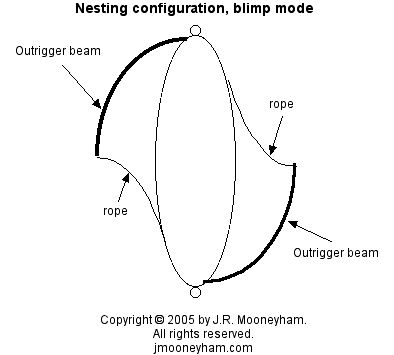
The outriggers would support Moonshadow's weight on the tree crowns while a lowered raft lowered the overall center of gravity. The rope or tensile member of the outriggers could be released to make it easier to withdraw the outrigger assemblies from the trees when the airship was deflated and the frame folded up to pull the whole ship down to the ground. Such releases could sometimes be necessary for launches as well, but I tried like heck to avoid that circumstance(!)
Although I lost all my original notes and drawings relating to Moonshadow due to confiscation by the authorities, I can still recall many aspects of its construction.
Power transfer systems
I used compressed air everywhere I could on Moonshadow. Running through PVC and aluminum piping where rigid members were required for other reasons, such as the internal framework, and flexible hoses for the remainder.
I used much of my compressed air piping as runways for tension structure members (ropes or cords) simultaneous with the air. Of course those tension lines typically had to enter and exit somewhere-- thereby compromising the airworthiness of the piping itself. Or at least they would have if not for my use of sliding plugs.
I used aluminum plugs inside the piping to allow simultaneous use of compressed air and cords in the framework. These babies were for the most part custom-made, with strong attach points on either end for cords or ropes, and notches for rubber O-rings around the circumference at both ends. A certain form of lubrication was required as well. This system allowed me to readily transfer tension forces through the rope system without undue loss of air pressure along the way.
I got the idea for the plugs partly from my previous construction job in Texas during my Shadowfast days. For the refinery had these big barrel-sized plugs called 'pigs' they would propel through pipelines to clean them out or whatever from time to time, using either air or liquid pressure behind them to do it.
Aerostatic technologies
My compressor flow was reversible to aid either rapid inflation or deflation of Moonshadow with it.
With the use of vortex tube technology I could also heat the air flow into the balloon while cooling the air beneath it simultaneously. Although I have no empirical data for it, in theory cooler air underneath meant denser air, which should have helped my aerostatic lift in general by some very slight amount.
With the control vortex tubes gave me over air temperatures, I could not only heat up the balloon air, but cool it too. So I used this method rather than spilling hot air like regular hot air balloonists (and didn't really have a formal method rigged for altitude altering spills). Of course, my learning curve had me attain some scary heights a few times before I realized the intricacies involved for my custom methods to work. And big changes in altitude could make for big changes in both wind velocity and direction as well. Not something to be taken lightly! Especially in the mountains!
Getting lost in the mountains in an airship is no fun whatsoever. For one thing you've got hard limits on your air time before you absolutely must land and acquire more supplies (like propane). But that's a whole other story in itself.
Note with the compressor and vortex tubes combo I could inflate/deflate and heat/cool for altitude adjustments fairly rapidly once I got the hang of it and made certain adjustments to my design. My partially insulated envelope reduced heat loss and so added to thermal and lift stability, while the presence of a conventional burner gave me additional heating power if needed.
Changing shape from blimp to wing also reduced aerostatic lift a bit, while my directional end/tip thrusters could help boost lift mechanically if desired (so long as no loss of air compression was going on).
I also used graduated insulating measures on the top inside surface of the balloon, to reduce heat loss and maximize performance and efficiency. The top-most 25% or so enjoyed the most insulation, with the 30% of fabric skin surrounding that getting a thinner working over, and the rest having no insulation at all.
The insulation was sprayed on from inside, in as uniform a manner as I could manage with my shop tricks. The insulation was pretty thin and lightweight stuff. I tried to make sure to go through all the calculations necessary to insure this would be a cost-effective measure beforehand.
Moonshadow blow gun
I had my mechanic brother build me a compressor-powered blow gun and various projectile stocks for Moonshadow. Due to weight concerns I didn't always have the blow gun mounted onboard, but I preferred having it with me when I could.
You might think of Moonshadow's blow gun as being analogous to a whaling ship's harpoon gun, mixed with a sea going ship's anchor.
Just a couple uses for the blow gun were for emergency manuevering or anchoring Moonshadow to a passing tree (definitely not something to try above a certain speed).
The blow gun was shoulder-fired, and somewhat resembled a bazooka, but was very lightweight. There were different methods for loading it, depending on what you meant your shot to do.
Anyway, even when I did take the blow gun onboard I rarely carried more than a dozen or so of its custom darts with me, for weight reasons.
Drop-safe harness
Virtually every item onboard Moonshadow not an actual part of the airship itself had to be tethered to the craft, or else risk being lost forever below. Including me. But I tried to arrange all the tethers to be as unobtrusive as possible, hanging from a rig above the raft, with spring-loaded retractors keeping excess lines out of the way but not tugging so hard as to cause problems themselves, and all those retractors being attached to rings which could themselves slide around on something like a shower stall curtain arrangement.
But of course nothing's perfect.
a - j m o o n e y h a m . c o m - o r i g i n a l
Critical weights and measures
At the time my personal weight was only around 140 pounds fully clothed, including on-person flight equipment. My small largely custom-built air compressor and generator arrangement plus small automotive-style battery totaled around 120 pounds altogether.
My 20 gallon propane fuel tank full ran around 90 pounds. I probably could have gotten by with a smaller tank most of the time. But having too much fuel usually wouldn't cause you nearly as many problems as having too little.
The frame, cabin-raft, envelope and various rigging all came to around 220 pounds.
My payload capacity beyond all the above was only around 100 pounds or so, not including my safety margin.
Ergo, Moonshadow's gross flying weight (including maximum payload and pilot onboard) was around 670 pounds.
Moonshadow's envelope volume? Around 82,000 cubic feet I believe.
Dimensions in blimp mode were roughly 340 feet long, and 115 feet high (not including the nose and tail thrusters, or control surfaces).
Keep in mind when perusing these figures I'm depending solely on personal recall here, with no original documentation to help. So mistakes are inevitable.
I used both the vortex tube and a burner to keep my air hot. Both the burner and my generator ran on propane.

Acoustic stealth
There were some sound problems with the various gear onboard: namely, noise. I did rig up a purposeful noise maker for 'sounding' distances to ground level under some circumstances, but the compressor, generator, and burner all could make their own not inconsiderable racket if you let them.
Moonshadow couldn't be fast like Shadowfast. Or as rapidly maneuverable as a helicopter or conventional airplane. All Moonshadow had was stealth and the power of flight itself, in terms of mobility advantages. So I had to do something about my involuntary onboard noise-makers.
Much of the problem I solved using an adaptation of firearms silencer technology, and graduated density pressure reduction. My method was a bit bulky but lightweight and pretty cheap in terms of what it cost me in generation and compression power output.
And as I basically used it as an array of vehicle power plant mufflers rather than gun silencer, it wasn't even illegal. At least in itself. And that's how I made Moonshadow so quiet.
Materials
I used a combination of aluminum conduit and plastic PVC pipe for framing which in some spots also carried compressed air. When I felt or found the need, I reinforced the PVC lengths in various ways against blow outs by tightly wrapping tough strapping tape around them. The aluminum of course I used where pressures would be highest, the PVC, the lowest. But keep in mind even PVC piping is designed to hold significant water pressures like those in household use-- pressures comparable to what I used here, only with air.
I did everything I could to make Moonshadow as light but strong as possible. Of course I didn't have access to things like titanium or carbon composites. But I did have access to fiberglass fabrication, aluminum conduit for compression members, synthetic cords and ropes for tensile structures, and thin but strong synthetic fabrics, netting, and screens.
Keep in mind Moonshadow typically flew only at night, and only in maximum darkness, which meant flights didn't usually last longer than four to six hours. And often just around an hour to an hour and a half. So although the gas and human energy consumption rates might be kind of high during flight, it usually didn't have to be sustained very long.
Staying at low altitudes helped too.
Moonshadow used sort of a hybrid automotive DC/AC system and smaller-than-average battery for electrical purposes. Again, I likely could have often gotten by without the main battery entirely, but disliked the idea of having inadequate backup for something as important as preparing for night landings or checking tree top clearance(!)
Stealth navigation lights
The most powerful lighting on the craft was a handheld spotlight with red filter on it to minimize the distance from which others would notice its beam.
The spotlight could be used as a steady beam or be manually blinked like a single strobe flash. The strobe flash is the mode I used most often so as to attract the least attention. The red color of the light helped too.
I'd flash the light anytime I needed to see just how close I was getting to the ground or tree tops. I also had a custom noise-maker which helped in this capacity sometimes.
I kept a directional hood on the spotlight for these navigational flashes, so no one would usually see my light directly unless they were smack in the hood-controlled beam. This made it much more difficult for any remote observers to locate my precise position. Or even tell it was an airborne source at all, in many cases.
I tried to avoid flying on clear nights with full moons.
And flying in daylight was downright foolish: though I admit I did do it a few times-- and not always for the best of reasons.
Bureaucratic camouflage
Just in case someone ever noticed me I tried to sow some confusion by painting certain US military experimental aircraft markings on Moonshadow in the appropriate places. Anyone running a check on the designation would see most of it was compatible with current military designations. And the incompatible parts? Well, I'd learned first-hand that much of the US government had not a clue what the rest of it was doing. So such small discrepancies could be easily chalked up to secret "need-to-know" programs. Most bureaucrats who'd been on the job longer than six months or so were well aware of this, and would tend to drop the matter at that point unless there was some pressing need to continue-- like an order from their boss. And the newbies who naively continued on would usually get shot down by their boss or peers the moment they admitted their extra digging to anyone.
So I figured I'd be fine so long as I avoided attracting undue attention to myself.
As I mostly used Moonshadow over wilderness, I didn't have to watch out for wires as much as other folks performing regular low altitude flying in the dark. My typical territory and low altitude also minimized chance encounters with other aircraft. Plus, I had pretty good visibility in Moonshadow everywhere but topside.
And in any case, official aircraft were always supposed to display running lights. So in theory I should always have been able to see one coming-- unless it was descending atop me. Or flying so fast I could neither hear or see it, even as it ran straight through me.
I knew there was a chance a fast combat jet on training missions or whatever might catastrophically spear me sometime. But I figured the odds were extremely low. Especially in the vicinity adjoining a major national park, with no significant military bases nearby.
But when you were actually riding along in Moonshadow its immensity made you feel the opposite: that you were a prime target, volume-wise. So I tended to jerk involuntarily whenever I heard the sound of a jet in the vicinity. Even when I wasn't onboard Moonshadow at all, after I'd spent some weeks flying it and letting the danger sink in.
Control surfaces
The great balloon wing did OK at providing both aerostatic and aerodynamic lift, but for maneuvering I had to use control surface flaps of fabric.
I had these huge slices of rectangular nylon cloth anchored to the rear edges of the wing at the outer tips (in wing mode). The cloth flaps were also each attached to a long fiberglass pole along their outermost edges (and short ones at their innermost). Through a system of high strength fishing line and strategically placed plastic eyelets I could pull down on these flaps or let up on them. The poles themselves were attached so as to give a good default position to the flaps when I did nothing, and acted like springs to return the flaps to default when I had nothing better for them to do.
The main rudder under the wing and behind the raft consisted of a similar arrangement.
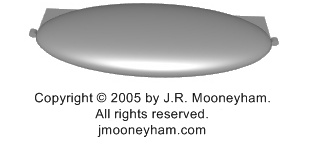
Above a head on view of the Moonshadow flying wing from a slightly higher altitude of the vessel itself.
|
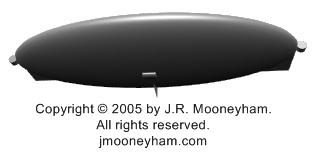
Above a head on view from below.
|
|
More about Moonshadow's nests
Moonshadow usually 'nested' among the tree tops of remote hills during the day. All it needed was a gap between crowns of around 110 feet or less, and we could land, tie off, deflate, and stay indefinitely in decent weather. If the weather turned bad (or some sort of aerial search was threatening us) we could always shrink up further and descend to the forest floor.
The top of Moonshadow's wing was camouflaged to roughly match the tree tops among which it rested. The bottom surfaces of Moonshadow were all painted sky blue.
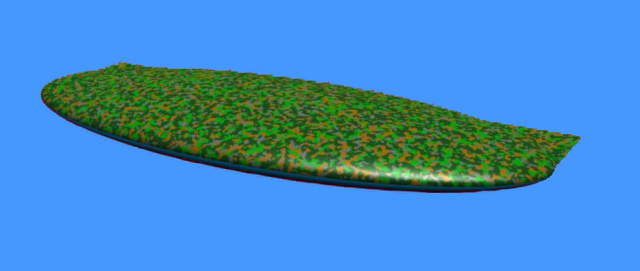
Artistic rendition of Moonshadow's woodlands camouflaged top half, by J.H. Mooneyham
(some items like windmill thrusters and rudder not shown here).
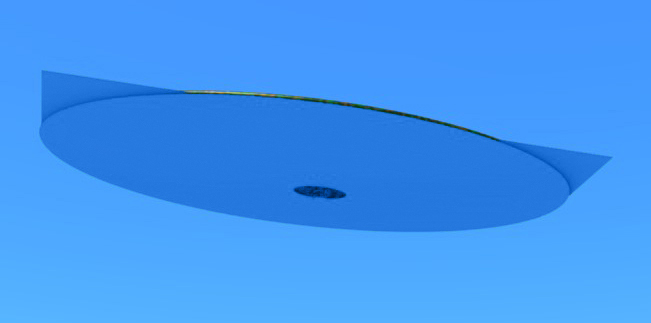
Artistic rendition of Moonshadow's sky blue camouflaged bottom half, from the rear, by J.H. Mooneyham
(some items like windmill thrusters and rudder not shown here).
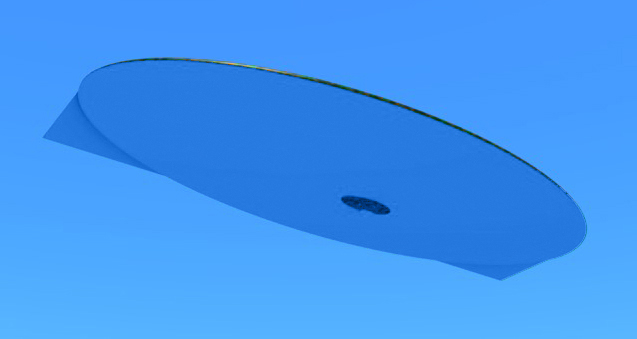
Artistic rendition of Moonshadow's sky blue camouflaged bottom half, from the front, by J.H. Mooneyham
(some items like windmill thrusters and rudder not shown here).
Moonshadow was extremely stealthy, although at that time stealth was not a commonly used term, and I was thinking "invisibility" instead.
Besides the camouflage paint on its outer surfaces, most of Moonshadow's construction materials likely didn't show up very well on radar either. And even where they did, the craft's relatively slow top speed and frequent hovering in one spot would have made it hard to identify as man-made too, I would think.
But as we mostly kept above and in-between the hills of my native country-side-- and at low altitudes-- we would also be often obscured by ground clutter.
Moonshadow was a low altitude flying machine, partly due to aerostatic limitations, but mostly because I didn't want to get very high.
Careful selection of nesting spots, Moonshadow's light weight, plus full extension of the outriggers usually prevented the belly of the envelope from acquiring much damage from tree branches. But if such did occur I had a repair kit for it.
I used rope ladders and a pulley system to get between the aircraft and the ground once it was nested.
I set up several different regular nest sites, and switched between them regularly. Each nest site was near one of my little ultra-high profit farms, and possessed its own small hideaway shelter and storage space, as well as dedicated pulley system and ladder, so that there I didn't have to go to the extra work of using Moonshadow's own equipment.
Though I toyed with the idea of building a true tree house at one or more of these spots, I never did so. Why? Because Moonshadow was itself pretty much the same as a treehouse. And I much preferred sleeping on the ground.
My ground shelters were pretty much invisible when not set up. I used the same design at two of the spots: A shape resembling an old-fashioned pup tent but made of treated and painted four by eight foot plywood sheets which latched together at the top to make the space, or could fold down flat atop one another on the ground. There was a trench dug length-wise under the hinged sheets, sufficiently deep that I could stand and walk upright beneath the peak created by the boards, and sleep or sit comfortably on the edges of the trench inside.
The trench was a handy place to store equipment and supplies when the shelter was folded flat and hidden under a large canvas tarp weighted with stones or logs at the edges and covered to match the forest floor.
The entire shelter floor was lined with plastic sheeting-- several sheets each separated by an inch or two of dry earth. In one site I found it necessary to construct a drain for rain runoff from a hillside above.
Note that you could also throw a few mothballs into the shelters before closing them up for a few weeks to help insure most pests stayed out or else died not long after they entered. Of course, a few life forms are resistant to moth balls, or else might not have time to die before your return. So encountering a snake or worm or two-- or really strange spider-- still kicking around wasn't out of the question.
But using the mothballs meant you needed to set up the shelter immediately upon arrival so it'd have a few hours to air out before you needed it. And even then you might need to maintain a good ventilation flow through the structure as you slept.
Mothball aromas are not the most pleasant of smells. And they're poison!
Note that unless there's a really unusual natural landmark close to your hidden shelter, you'd better make darn sure to make your own. Else you might lose that particular bit of hard work forever.
And yes, I lost a shelter myself that way once, when I forgot to make a landmark. Never did find it again. Damn it. And it was holding enough harvested 'crop' to buy a new car! That was at a fourth site that I eventually abandoned due to having spread myself too thin one summer. Plus, it was the most distant from all the rest.
At my third site the surroundings offered sufficient natural rock protections that I usually made do with a simple plastic sheet, some stone weights, and a rope for backbone to create a triangular plastic tube for protection from wind and rain. That was the only place I ever used a camp fire, as it was so well hidden from distant passers by.
To save myself some labor I set up solar traps at two of my sites. Meant to do the same at the third but never got around to it. So visiting number three was always onerous.
Anyway, my little 'farms' were always well situated to catch maximum sunlight during the day. Sure, I couldn't interfere with the light going into the chasms, or do anything which might attract attention to the site, but I darn well could collect solar heat to help warm up Moonshadow's balloon after dark, and did.
Basically discoloring the natural rocks in the area a bit to something darker than their normal shade would make them absorb more solar heat during the day. Lugging in more rocks from elsewhere added to the sink. Then, by around the mid-afternoon time any government searchers and most civilian explorers in the area would be calling it quits and returning home for the day, you could unroll several enormous plastic sheets over all your nice hot rocks, roughly sealing the sides with weights but leaving the ends facing downhill open (even propping them wider open), and configuring the top-most edges to direct all their air flow to one or more really really long and camouflaged dryer hoses hugging trees to attach to your balloon.
Such an arrangement could help well to pre-heat and inflate the balloon. But of course I also had my compressor, vortex tubes, and burner for added power there. But the more I used solar, the less propane I had to lug out to my nest sites.
The Moonshadow transportation advantage for outlaw farming
Some readers may not realize just what benefits Moonshadow presented to an outlaw farmer in those days.
Think about it: Moonshadow allowed me relatively easy access to vast tracts of mountain wilderness such as no one else could possess-- not even park rangers, law enforcement, or the military in helicopters or on foot.
This access let me pick and choose my de facto real estate with far fewer restrictions than other outlaws of my day, who had to make do with hiking on foot, or using trail bikes or four wheel drives or dune buggies. I was literally in a class of my own, site-selection-wise.
And you know the cliche: the most important three things in real estate are location, location, and location.
My near exclusive use of Moonshadow after dark and only within the borders of my private little mountain empire made it near impossible for anyone to track or follow me to discover the whereabouts of my farms, too. A liability virtually all my competitors had to deal with.
So my farms weren't where the law expected them to be. Which helped minimize the threat of their searches to me. And they couldn't track me. Which meant I had far fewer worries about surveillance and such.
I also utilized various camouflage tricks too though, just in case. Mentioned elsewhere are some methods used with Moonshadow itself. But I also researched foliage shades and thermal signatures to throw off searches in that manner as well.
Ever hear the one about the frog jumping out of a pan of water quickly heated, but staying in and cooking if the heat is very slowly turned up instead? Well, I did the same in regards to my farms for the law. Namely, made sure to cause subtle and gradual changes in the color and warmth of the surrounding terrain so that my farms wouldn't stand out in various high tech detection measures of the time.
Of course that just increased the pressure on my competitors. But business was business.
a - j m o o n e y h a m . c o m - o r i g i n a l
As those tactics might still be useful circa 2005, outlaw farmers might do well to do their own studies in those areas. Unfortunately I better not go into more detail here. For obvious reasons.
Seasonal Moonshadow storage and launching
Though I'd tried to design Moonshadow for relatively easy construction and disassembly, it was still a hellacious task to do either, for a single person. I definitely didn't look forward to such at the beginning and ending of a season.
Worse, I couldn't seasonally store Moonshadow where I'd first constructed him. Plus I didn't want to store all his components in the same place anyway. For if someone intelligent found them they might guess their nature and build it and fly off with it themselves (wow, was I paranoid or what?). If someone dumb found them, they might simply steal them or wreck them.
Even back then I couldn't see myself rebuilding all those components from scratch a second time.
So what'd I do? At season's end I would nest Moonshadow at the spot which seemed most likely to remain safe over the coming months based on what I'd seen in the most recent period.
Then, beginning from the bottom, I'd take him apart, and lower the parts to the ground with my pulleys and ropes.
The raft could be deflated and crammed into a single nest shelter along with certain other accessories.
The great balloon would naturally deflate fairly quickly when not in use-- and go down even faster with a reverse compressor flow. But at season's end when you were packing up you wanted to tightly control the deflation process to make exiting a lot easier.
I don't want to give too many secrets away on this topic, as it's one of the more important here. But in general it has to do with planning ahead and making sure your last nesting site will be conducive to putting away the collapsed balloon and frame.
The rest of that topic I'll leave you to figure out on your own.
The control surface items themselves could be easily prepared and buried.
Anyway, the packing up process would still leave me with around a pickup truck load worth of items I wanted to haul out with me. These I had to hide as best I could in one location and then return as soon as possible with a vehicle to retrieve them.
Logistics: the supply line between Moonshadow and civilization
I used several different ground transportation techniques during my time with Moonshadow. Keep in mind Moonshadow never traveled in any ground vehicles at all except as disassembled parts.
Moonshadow also usually nested nowhere near ground vehicle roads. Except at the very beginning and ending of a season, of course. And even then I tried to make it quite a chore for anyone on foot coming from the nearest available ground vehicle road to get to our nest-- even if they knew exactly where to go.
Eventually I hit upon a truly nifty system that saved me a lot of personal wear and tear, while also providing me with some much needed recreation: safari parties. I'd finance a safari party for several guys I knew (usually men rather than women for maximum cargo carrying purposes). I'd collect them all up in my pickup truck with camper and head for a good hidden spot to park within walking distance of the camp site I'd chosen and prepared. Then we'd walk in, with all of us toting locked backpacks also provided by me. I told everyone I kept them locked so we couldn't accidentally lose any goodies along the way, etc., etc.
Some of the backpacks of course carried party supplies. But others carried Moonshadow supplies.
I had two full sets of these backpacks, each identical to the other. And would switch out the non-party-supply packs with others hidden at the camp site while we were there.
This system made it possible for me to have considerable unknowing help carrying in supplies for Moonshadow operations while at the same time carrying out crop yields.
It wasn't usually very difficult to recruit folks for the parties.
Of course I had to personally transport stuff from the camp sites to the nearest nest site and vice versa. But it worked pretty well in practice, with by far the worst of it taking place at the beginning and ending of a season.
I tried to keep only minimal supplies and equipment onboard Moonshadow at any given moment, with the bulk of my stuff kept at my nesting sites. Because the lighter Moonshadow was, the less work I had to do hauling propane and the like. Or going to town to buy more.
Transporting a full propane tank was the most frequent fairly robust manuever required of the whole operation, which couldn't easily be divvied up into smaller, less strenuous tasks.
Fortunately my little old VW bug and certain other off-road equipment left over from my Shadowfast days was helpful in some cases for this. Keep in mind bugs like mine were often converted into dune buggies used for off-roading. What lots of people didn't know was plain un-modified bugs were also pretty decent at off-roading or bad terrain conditions in many cases. Being generally lightweight helped, plus having the motor and transmission pretty much sitting atop the driving wheels made for optimal traction. Stuff like that. Although the interior space was limited you could strap quite a bit onto the exterior body for transport too. Combine the bug with a short bed pickup truck and occasional motorcycle runs and you get a pretty flexible system for transporting supplies too heavy or bulky for hiking in and out on foot, even via safari parties and unwitting guests...
There's more details to come as I get the time to post them...
Copyright © 2005-2009 by J.R. Mooneyham. All rights reserved. Some images of Moonshadow were created in Blender by my nephew J.H. Mooneyham.

